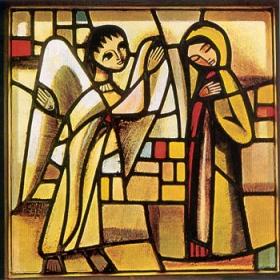Vocabulary
ᎬᏲᎵᎦ - I greet you
ᎡᏣᎸᏉᏔᏅᎯ - you are beloved
ᏱᎰᏩ ᏫᏗᏣᎧᎿᏩᏗᏓ - God sends you a message
ᏭᏓᎪᎾᏛᏗ - profoundly
ᎡᏣᎸᏉᏗᏳ - you are blessed, honored
ᎾᏍᎩ ᏨᏘᎾᏄᎪᏫᏏ - the one you shall give birth to
ᎢᎦᏤᎵ - our
ᎤᎬᏫᏳᎯ - Lord (leader, chief, etc.)
ᎯᏥ - you are his mother
ᏚᏙᎥ - he is named
ᎢᏍᎩᏯᏓᏙᎵᏍᏓᏍᏏ - pray for all of us
ᎣᏥᏍᎦᎾᏥᏙᎯ - we sinners
ᎢᏍᎩᏯᎩᏓᏙᎵᏍᏓᏁᎸᎢ - pray for us
ᏤᎲᎾ ᏂᎦᎵᏍᏔᏅᎯ - when we die (when we not living become)
ᎡᎺᎾ - Amen
ᎢᏍᎩᏯᏅᏓᏗᏍᎨᏍᏗ - remember us

ᎬᏲᎵᎦ ᎺᎵ, ᏂᎯ ᎡᏣᎸᏉᏔᏅᎯ
Gvyoliga Meli, nihi etsalvquotanvhi
Hail Mary, full of grace
ᏱᎰᏩ ᏫᏗᏣᎧᎿᏩᏗᏓ.
Yihowa widitsakahnawadida.
the Lord is with thee.
ᎠᏂᎨᏴ ᎠᏁᎲ ᏂᎯ ᏭᏓᎪᎾᏛᏗ ᎡᏣᎸᏉᏗᏳ
Anigehya anehv nihi wudagonadvdi etsalvquodiyu
Blessed art thou among women
ᎠᎴ ᎦᎸᏉᏗᏳ ᎾᏍᎩ ᏂᎯ ᏨᏘᎾᏄᎪᏫᏏ, ᏥᏌ ᏚᏙᎥ.
ale galvquodiyu nasgi tsvtinanugowisi, tsisa dudo'v.
and blessed is the fruit of thy womb, Jesus.
ᎡᏣᎸᏉᏗᏳ ᎺᎵ, ᎢᎦᏤᎵ ᎤᎬᏫᏳᎯ ᎯᏥ,
Etsalvquodiyu Meli, igatseli ugvwiyuhi hitsi,
Holy Mary, (thou) mother of our Lord
ᎢᏍᎩᏯᏓᏙᎵᏍᏓᏍᏏ ᎣᏥᏍᎦᎾᏥᏙᎯ
Isgiyadadolisdasi otsisganatsidohi
Pray for us sinners (now)
ᎠᎴ ᎢᏍᎩᏯᎩᏓᏙᎵᏍᏓᏁᎸᎢ ᏃᏤᎲᎾ ᏂᎦᎵᏍᏔᏅᎯ
ale isgiyadadolisdanelvi notsehvna nigalstanvhi.
and pray for us at the hour of our death.
ᎡᎺᎾ
Emena
Amen
The “Ave Maria” or "Hail Mary" prayer goes back centuries and is much
beloved especially among Catholics. The first lines of this prayer are
taken directly from the New Testament verses Luke 1:28 and Luke 1:42.
The last line, the petition for prayer, was added in the late 15th
century. Ultimately it was this version that was added to the Roman
Catholic Catechism in the 16th century.
Repeating this prayer multiple times in the Rosary is supposed to keep
one mindful of God’s presence in our lives. The Catholic and Orthodox
churches ask saints to intercede for those on Earth since the saints
have entered glory, have worked miracles, and are considered to now be
closer to God. Mary has a very special status since she was the mother
of Jesus.
I first encountered this prayer via music. There are many beautiful
musical settings of the prayer but the versions put to music by
Schumann and Charles Gounod's setting of it to a Bach sonata are among
the most beloved. The Schumann setting is the version that is used in
Disney’s “Fantasia”. It’s usually sung in Latin since all of the Roman
Catholic liturgy was in Latin until the reforms of the early 60’s when
translations into local languages were encouraged.
ᎠᏴ ᏔᎻᎵ
Here is an alternate version of last two lines using an alternate
form for "pray for us" that is in the Cherokee New Testament that
translates to "pray remembering us":
ᎭᏓᏙᎵᏍᏗᏍᎨᏍᏗ ᎠᏴ ᎢᏍᎩᏯᏅᏓᏗᏍᎨᏍᏗ ᎣᏥᏍᎦᎾᏥᏩᏙᎯ
Hadadolisdisgesdi ayv isgiyanvdadisgesdi otsisganatsidohi
Pray, remembering us sinners
ᎭᏓᏙᎵᏏᏓᏁᎸᎢᏃ ᎢᏍᎩᏯᏅᏓᏗᏍᎨᏍᏗ ᏃᏤᎲᎾ ᏂᎦᎵᏍᏔᏅᎯ.
hadadolisdanelvihno isgiyanvdadisgesdi notsehvna nigalstanvhi
And pray (at that time in the future), remembering us when not living
we become and pray for us at the hour of our death.

